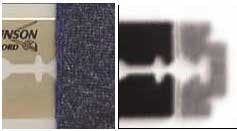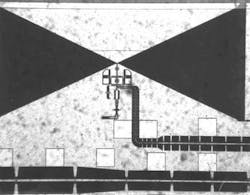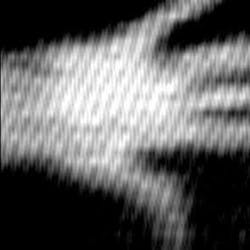While microwave and x-ray technologies still make up the majority of imaging systems used for security applications, another part of the electromagnetic spectrum—terahertz—is emerging as a complementary technology for both structural imaging and spectroscopy. The terahertz region encompasses frequencies between microwave and infrared, in the range of 100 GHz to 30 THz. Over the past decade, research in this part of the spectrum has been hampered by a lack of adequate sources and detectors, but recent advances in ultrafast lasers, oscillators, quantum-cascade lasers, and heterojunction diode and transistor circuits have led to the development of a new generation of terahertz imagers that are taking this technology out of the laboratory and into the practical realm.
Much of the initial research in terahertz imaging took place in the early 1990s at AT&T Bell Labs (Holmdel, NJ) under the direction of Binbin Hu and Martin Nuss. The resulting technology, based on optoelectronic terahertz time-domain spectroscopy, was licensed to Picometrix (Ann Arbor, MI) in 1998; one year later, Picometrix introduced the first commercially available terahertz imager.
With the growing desire to better detect and monitor terrorist activities, the emphasis in many terahertz circles has shifted to security applications. The goal is to leverage the inherent advantages of terahertz waves—most notably the ability to image inside dielectric materials such as cloth, leather, plastic, cardboard, and common packaging materials, and distinguish different chemical compositions inside those materials (see Fig. 1). While microwave and x-ray imagers produce density pictures, terahertz rays go a step further, providing spectroscopic information within the terahertz frequency range. Certain parts of the terahertz spectrum also lend themselves to remote sensing of unknown gas clouds and airborne biohazards.
FIGURE 1. Terahertz waves penetrate dielectric materials such as cloth, leather, plastic, cardboard, thin walls, and common packaging materials and provide spectroscopic information. The visible image shows a razor blade obscured by two layers of denim material (left). With a terahertz imager, the entire razor blade can be detected clearly (right).
null
"Spectral information is the power of the terahertz regime," said Chris Mann, project manager for the StarTiger terahertz development program sponsored last year by the European Space Agency (ESA; Paris, France). "Everything has a spectral signature, and all materials emit terahertz waves, each having its own frequency pattern as a kind of 'fingerprint.' "
Applications near and far
Terahertz imaging systems are now under development for applications such as powder detection, screening for concealed weapons, and bioagent analysis. Although remote terahertz imaging at frequencies below 0.5 THz is possible up to a few kilometers, use of frequencies above approximately 0.5 THz is primarily limited to short-distance spectroscopic applications, such as bioagent and soil analysis, and should eventually find a place in whole-body imagers, once the technology becomes more compact and less expensive.
"Terahertz radiation does not penetrate very far into the atmosphere, although there are windows in the atmospheric spectrum where terahertz radiation does propagate a reasonable distance," said Mark Sherwin, a professor of physics at the University of California, Santa Barbara (UCSB), who oversees several terahertz projects at the university. "If you are looking through someone's clothes a few feet away, there are windows of transparency at 2.5 and 1.6 THz and a fairly wide window at about 3 THz."
TeraView (Cambridge, England), a spinoff of Toshiba Europe's Research Laboratory, originally targeted its core technology at medical and dental applications but is now looking to adapt its terahertz platform for security applications, including postal inspection, object detection, chemical and bioagent detection, and landmine detection. The system contains a femtosecond diode-pumped Ti:sapphire laser oscillator tunable in the 750- to 890-nm range, a terahertz generator, coupling optics for the terahertz beam, and time-resolved electro-optical sampling.
"We have a development-stage product that uses the lower-frequency portion of the spectrum and can be configured for various applications," said Don Arnone, president of TeraView. "We are now looking at using this platform and developing a user interface for a security screening probe, initially as a second-stage screening device."
Similarly, technology originally developed at the Center for Terahertz Research at Rensselaer Polytechnic Institute (RPI; Troy, NY) for biomedical applications is being investigated for other short-range spectroscopic applications such as the detection of explosive materials and bioagents (see Laser Focus World, July 2002, p. 23). In a test, the group's 0.3-THz chirped-probe-beam terahertz-imaging system scanned a postal envelope in two dimensions, distinguishing between 80-mg samples of flour, salt, baking soda, and seasoning.
To more accurately assess the applicability of terahertz imaging to anthrax detection, the researchers also considered samples of bacillus thurengiensis bacteria spores. According to Xi-Cheng Zhang of RPI, the Fourier transform of the terahertz waveform provides information on the frequency-dependent scattering, absorption, and refractive index of each sample. This technology is being commercialized through a startup called Zomega Technology (Melrose, NY).
Basic science
Several research groups are working to overcome the technical issues that are likely to delay the introduction of commercial terahertz systems for another year or two. These limitations include water absorption and related signal-to-noise ratios, long data-acquisition times (tens of minutes to hours for a single image), lack of terahertz-specific optical components, and limited source power for large-scale imaging (except for free-electron lasers).
As part of the European Teravision program, for example, researchers at Delft University of Technology (Delft, The Netherlands) have built terahertz sources and detectors based on Ti:sapphire femtosecond laser oscillators and have developed a terahertz generation and detection scheme with the highest dynamic range in the world for these oscillators, according to Paul Planken, professor of applied sciences at Delft. By using lock-in detection at 50 kHz, they can measure the terahertz signal at a modulation frequency at which the laser noise is minimal.
"We currently measure a full 35-ps-long terahertz electric field with a dynamic range of more than 5000 in a total measurement time of 20 ms," he said. Planken and his colleagues have also developed a new method to overcome the diffraction limit in terahertz imaging and have improved the resolution of terahertz imaging by a factor of almost 1000.
Free-electron lasers are being used to demonstrate high-power terahertz capabilities and speed materials research. At Thomas Jefferson National Accelerator Facility (JLab; Newport News, VA), researchers have generated terahertz rays at nearly 20-W average power—20,000 times stronger than previous attempts. In an experiment conducted in November 2001 by Gwyn Williams, scientists from JLab, Brookhaven National Laboratory and Lawrence Berkeley National Laboratory produced high-average-power broadband emission from 500-fs electron bunches in the JLab FEL's SRF accelerator. Williams and George Neil, the FEL facility manager at JLab, have formed a company called Reletec to license some of the findings from the T-ray experiments for use in large imaging systems, such as the measurements of the terahertz response of potentially dangerous materials and imaging plastic explosives in nonmetallic dry structures.
Similarly, researchers at the Center for Terahertz Science and Technology at UCSB are working with two FELs to do materials research and proof of science in the 0.12- to 5-THz range, with peak powers of 1 kW. Through their research, they have developed a new detector, TACIT (tunable antenna-coupled intersubband terahertz), that could be used for security applications, much like a tiny spectrometer on a chip. They are also looking at terahertz detection of bioagents.
Optical vs. electronic sources
The current size, cost, and field-deployability limitations of most terahertz imagers have prompted other research groups to focus on electronic sources for terahertz-wave generation, as opposed to the more popular optical methods (illuminating a semiconductor crystal, such as gallium arsenide, with femtosecond pulses of visible light). Daniel van der Weide and colleagues at the University of Wisconsin (Madison, WI) are developing a compact terahertz system that uses electronic circuits to produce short pulses in the 0.1- to 10-THz range for remote imaging, and they are looking to commercialize this technology through a spinoff company (see Fig. 2). "Although laboratory results from optoelectronic terahertz systems dominate the recent literature, field-deployable terahertz technologies for rugged, compact, and ultimately low-cost screening and sensing will be based on electronics," said van der Weide.
FIGURE 2. A terahertz system developed at the University of Wisconsin uses a broadband bowtie antenna integrated with an integrated electronic circuit called a nonlinear transmission line and sampling detector to generate short pulses in the 0.1- to 10-THz range.
null
According to van der Weide, the University of Wisconsin system is more practical than an optical or electro-optic system and can be scaled to the chip level. In addition, the wavelengths can be treated quasi-optically the same way laser-based systems work, which is of particular interest for field-deployable applications.
"We are looking for distinct reflections as a function of frequency and spectral signatures that indicate the presence of concealed threats," van der Weide said. "We have done an extensive amount of spectroscopy on plastic explosives, which is of extreme interest to the aviation industry, and bioagents such as anthrax." His group is also targeting the 0.1- to 0.6-THz portion of the spectrum for remote sensing.
The ESA-sponsored StarTiger program also focused on non-electro-optic terahertz technologies. More important, the StarTiger team achieved something no one in the terahertz community had done before: they built a compact, low-cost terahertz imager in just four months, using manufacturing techniques adapted from the silicon industry. The system was completed last October and has captured the first terahertz picture of a human hand (see Fig. 3).
FIGURE 3. The ESA-sponsored StarTiger terahertz imager, built in just four months using manufacturing techniques adapted from the silicon industry, was completed last October and has captured the first terahertz picture of a human hand.
null
The imager built by the StarTiger team operates at 0.25 and 0.3 THz and uses heterodyne detection to create two-color images with contrast between materials with different transmission and reflection properties. One of the main advantages of the StarTiger imager is that it does not emit any radiation; it is a passive camera capturing pictures of the natural terahertz rays emitted by almost everything. In addition, the StarTiger team developed new technologies that should further advance the creation and fabrication of terahertz devices, including a two-color micromachined waveguide array the size of a postage stamp, a photonic bandgap mixer, and a micromachined room-temperature detector.
"Terahertz technology is evolving fast, and current electro-optical terahertz systems with a laser are on the order of a few hundred thousand dollars and weigh about 50 kg or less," said Robert Osiander of the Applied Physics Laboratory at Johns Hopkins University (Baltimore, MD), which is using funding from an Army Research Office multi-university research initiative to investigate optical terahertz spectroscopy for trace explosives detection. "The parallel development of electronic sources will make terahertz less expensive and much smaller, because they can be developed for the frequency range of interest."


